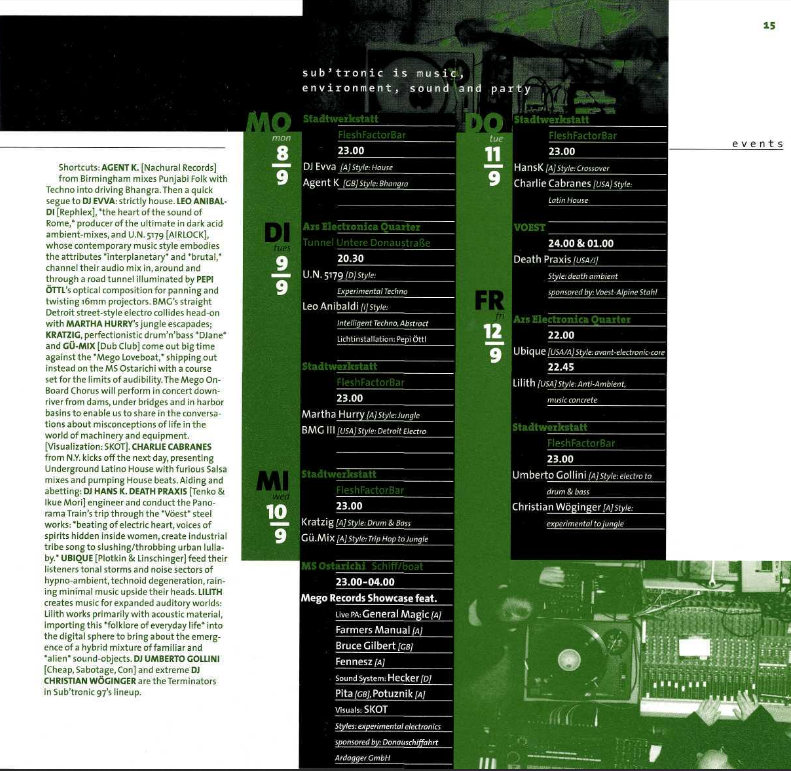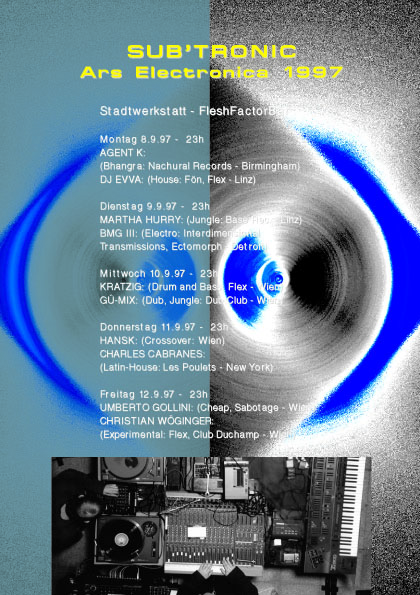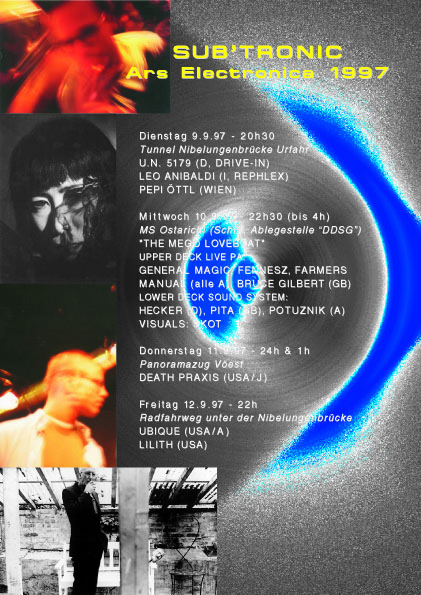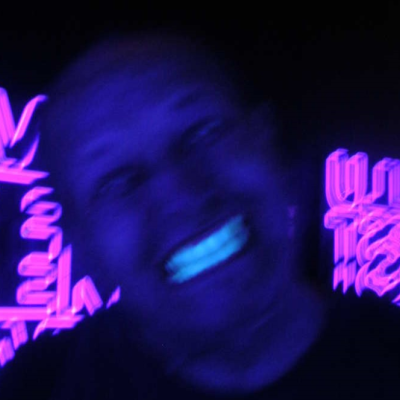Curator September 8, 1997
Curator: Ars Electronica: Subtronic 1997

Ars Electronica: Subtronic 1997
Curated by Wolfgang Fadi Dorninger
Mo - FR / mon - fri 8. - 12. 9./ Ars Electronica Quarter/ Stadtwerkstatt
Scroll down for the english text
AGENT K. (Nachural Records) aus Birmingham mischt Punjab-Folk mit technologischer Musik zu treibendem Bhangra. Kontrastprogramm: DJ EVVA: striktly house. LEO ANIBALDI (Rephlex), 'the heart of the sound of rome', Produzent ultimativer dark acid ambient-mixes und U.N. 5179 (AIRLOCK), dessen zeitgenössischer Musikstil die Attribute sphärisch und brutal verkörpert, bespielen einen Straßentunnel, durchleuchtet von PEPI ÖTTL’s optischer Komposition für geschwenkte und gedrehte 16mm-Projektoren. BMG’s, straight Detroit street style electro trifft auf MARTHA HURRY’s jungle Eskapaden, KRATZIG, perfektionistische Drum’n’Bass ‘DJane’ und GÜ-MIX (Dub Club) treten gegen das 'Mego Loveboat' an, um an die Grenzen des Hörbaren mit der MS Ostarrichi zu schiffen. Die Mego Bordkapellen (siehe Raster) werden Konzerte in Absinkbecken von Staudämmen, unter Brücken und Hafenbecken geben, um uns an Konversationen über Mißverständnisse des Lebens in der Apparatewelt teilhaben zu lassen (Visualisierung: SKOT). Underground-Latino-House, mit furiosen Salsa-Mixes und pumpenden House-Beats präsentiert tags darauf CHARLIE CABRANES aus N.Y., DJ HANS K. assistiert. DEATH PRAXIS (Tenko & Ikue Mori) befahren mit dem Panoramazug die Vöest: 'beating of electric heart, voices of spirits hidden inside women, create industrial tribe song to slushing/throbbing urban lullaby'. UBIQUE (Plotkin & Linschinger) schleudern dem Zuhörer Klanggewitter und Geräuschflächen aus Hypno-Ambient, technoider Degeneration und minimal music um die Ohren, während LILITH Musik für expandierende Hörwelten schafft. Lilith arbeiten vornehmlich mit akustischen Materialien und importieren diese 'Folklore des Alltags' in den digitalen Raum, bis eine hybride Mischung aus bekannten und ‘alien’haften Soundgebilden entsteht. DJ’s UMBERTO GOLLINI (Cheap, Sabotage, Con) und der Extrem-DJ’s CHRISTIAN WÖGINGER beenden den Sub’tronic-Reigen 97.
Program:
Live PA: Mego "Love Boat" feat. General Magic, Farmers Manual, Fennesz, Pita [all A], Hecker [G], and Bruce Gilbert [UK); others: Ikue Mori [J] & Tenko [USA], Plotkin [USA]/ Linschinger [A], Leo Anibaldi [I], Lilith [USA], Ubique [USA/A], U.N.5179 [D]
DJs: Charlie Cabrañez [USA], Agent k [UK], BMG [USA], Martha Hurry [A], Umberto Gollini [A], Christian Wöginger [A], HansK [A], Gü.Mix [A], Kratzig [A], BMG III [USA], Dj Evva [A]
Visuals: Pepi Öttl [A]
Montag 8.9.97 - Stadtwerkstatt FleshFactorBar
Agent K (GB) Bhangra ist ein Folklore-Tanzstil aus dem Punjab (Nord-Indien und Pakistan), der bei Hochzeiten, Erntefeiern und wichtigen Anlässen zelebriert wird und durch Emigranten in die Welt hinausgetragen wurde. In England wurde Bhangra mit Techno, Ragga, Disco und Jungle durch die ‚britanisierte‘ Punjabi-Jugend fusioniert und wegen der großen Nachfrage sogar nach Indien re-exportiert. Nachural Records und Agent K aus Birmingham stehen für diesen Sound.
DJ Evva (A) Das Kontrastprogramm wird an diesem Abend von DJ Evva, einer der gefragtesten und konstantesten House-DJ’s Österreichs bestritten.
Dienstag 9.9.97 - Tunnel Nibelungenbrücke Urfahr
U.N. 5179 (D) U.N.5179, der Live-Act aus dem Hause AIRLOCK, dessen Label Drive-In mit bisher 6 eigenwilligen Veröffentlichungen das Spektrum zeitgenössischer Musik von 'sphärisch' bis 'brutal' großzügig abdeckt. Hörtip: Drive-In 05 Ultra Blue 'Fangataufa E.P.'
Leo Anibaldi (I) Leo Anibaldi veröffentlichte auf dem italienischen ACV Label unglaublich verstörende dark acid Platten („Cannibald„, „Muta„), die ihm in London das Attribut „the heart of the sound of Rome„ einbrachten. Mit der Übersiedelung nach London und der Veröffentlichung von „Void„ (Rephlex) konnte Leo Anibaldi 1996 eines der ulitimativen Techno-Ambient Alben des Jahres verbuchen. Die Dichte seiner Musik entsteht durch vielschichtige Ebenen aus Geräuschen die zu Beats werden und reduzierten Melodien, die Sub-Räume zur Geräuschwelt öffnen.
Pepi Öttl (Wien, Bilderwerfer, Panoptischer Kreis) Die beiden Konzerte werden durch optische Kompositionen für geschwenkte und gedrehte Projektoren (8 Stück 16mm Projektoren und 8 Stück Diaprojektoren) von Pepi Öttl visualisiert. Öttl ist Filmemacher für bewegte Lichtinstallationen, nicht für die Leinwand.
Dienstag 9.9.97 - Stadtwerkstatt FleshFactorBar
Martha Hurry (A) Von der Violine zu Jungle und mit einer eigenen Produktion 'Matta' (base records) wieder zurück. Die promovierte Violinistin Martha Breit gehört zu den heimischen Pionieren des Jungle, immer dem Motto treu: 'breakbeats till you die!'
BMG III (USA) Brendan M. Gillen III ist DJ und Producer. Er arbeitet beim Label Planet E in Detroit (Carl Craig) und veröffentlicht unter dem Namen 'Ectomorph' und 'LATEX' (neuer Act). Sein Sound ist 'straight Detroit street style electro', die er als DJ mit allen Sorten von electronic funk bis strange electronic music mischt.
Mittwoch 10.9.97 - Stadtwerkstatt FleshFactorBar
Kratzig (A) Angelika Kratzig (Wien) ist Musikerin und DJ (Drum’n’Bass) mit Hang zur Perfektion und demnächst auch Produzentin mit eigenem Tonstudio.
Gü-Mix (A) Mitbetreiber des Dub-Clubs (Flex) in Wien. Demnächst erscheint auf Dub-Club Records der erste Gü-Mix Tonträger mit Remixes von Dorfmeister und Pulsinger.
Mittwoch 10.9.97 - MS Ostarichi (Schiff) 23h (bis 4h)
'The Mego Loveboat' Upper deck live PA: General Magic (A), Farmers Manual (A), Bruce Gilbert (GB), Fennesz (A) Lower deck sound system: Hecker (D), Pita (GB), Potuznik (A) Visuals: SKOT
Das Wiener Label 'Mego' wird uns mit seinem 'Loveboat' an die Grenzen des Hörbaren schiffen, uns an Konversationen über Mißverständnisse des Lebens in der Apparatewelt teilhaben lassen und Systemabstürze zu akustischen Feiertagen verwandeln. Einsteigen, ablegen und Konzerte an seltsamen Orten hören, unter einer großen Donaubrücke, im Absinkbecken eines Staudammes und im Hafen einer Industrielandschaft. Gesteuert wird das Loveboat von oben genannten Bordkapellen.
Donnerstag 11.9.97 - Stadtwerkstatt FleshFactorBar 23h
HansK (A) Hans Kulisch (Wien) ist ein anything-goes-Fetischist mit Hang zum "wirklichen" Crossover - Weltmusik abseits von Techno.
Charlie Cabranes (USA) Underground-Latino-House, mit furiosen Salsa-Mixes, fetten Bässen und pumpenden Housebeats von Masta Cabranes aus New York City (Vinyl, Les Petites).
Donnerstag 11.9.97 - Ridin' A Train - Vöest
Ikue Mori & Tenko (USA/J) Tenko’s reiche musikalische Karriere startete in den 70ern in Japan als Mitbegründerin von 'Mitzutama Shobodan' (Polka-Dot Fire Brigade), die mit der Rolle des traditionellen japanischen Frauenbildes in der Darstellung brachen. 1984 erschien Tenko in der New Yorker Musikszene als Solistin, tourte aber sehr bald mit Kollegen wie David Moss, John Zorn, Christian Marclay, Fred Frith oder wie 1993 mit Butho Tänzer (Uzumi Ashikawa).
Über die vergangenen zwanzig Jahre hinweg hat die japanische Perkussionistin Ikue Mori einen eigenen Zugang zum Rhythmus entwickelt. Ihre Anfänge als Schlagzeugerin der Gruppe DNA sind auf dem legendären und wegweisenden 'No New York'-Sampler dokumentiert. Inzwischen spielt Ikue Mori nur noch mit drei selbstprogrammierten Schlagzeugcomputern, denen sie seltsam gebrochene Rhythmen entlockt. Hier hört man keine Vierviertel mehr, sondern irritierend übereinandergeschichtete Muster aus vorbereitetem Klangmaterial. 'Death Praxis', das Projekt von Tenko und Ikue Mori, pendelt zwischen den Welten von ursprünglicher Volksmusik aus Okinawa, old Tokyo, den Straßen von New York, rezitierten Trance-Monologen und Todesgesängen. Kanalisiert werden diese Stimmwelten vom organischen Rattern und Dröhnen von Ikue Mori’s Drummaschinen.
Freitag 12.9.97 - Radfahrweg unter der Nibelungenbrücke
Ubique (USA/A) - 22h Der für seine experimentelle-metal-freakout-Band OLD sowie für die Zusammenarbeit mit so verschiedenen Artisten wie Mick Harris (SCORN), Michael Gira (SWANS), K.K. Null (ZeniGeva) bekannte Gitarrenmanipulator James Plotkin trifft auf den Synthetiker Joseph Linschinger (FUCKHEAD, AURAL SCREENSHOTS). Gemeinsam schleudern sie mit ihrem aktuellen Projekt UBIQUE analog/digitale Klanggewitter und Geräuschflächen aus HypnoAmbient, technoider Degeneration und minimal music dem katatonischen Zuhörer Stück für Stück um die Ohren: sonic patterns on obscure ground. UBIQUE is Plotkin - guitar tranformations & Linschinger - sampling, cutting, physical modelling.
Lilith (USA) Lilith aus Chicago bezeichnen ihre Musik als 'Anti-Ambient', da sie nicht Musik für erweiterete Raumsituationen schaffen, sondern für expandierende Hörwelten. 'We ask you to listen' ist das Motto der 1986 in Chicago gegründeteten Gruppe, die auf unzähligen Labels (Sub Rosa, Ladd-Frith, White Noise) bereits an die 20 Tonträger veröffentlichte; Filmmusik, Multimedia-Stücke und Tanzmusik ausgenommen. Lilith arbeiten vornehmlich mit akustischen Materialien und importieren diese 'Folklore des Alltags' in den digitalen Raum des Sampler, wo die natürlichen Klänge solange bearbeitet werden, bis eine hybride Mischung aus bekannten und 'alien'haften Soundgebilden entsteht.
Freitag 12.9.97 - Stadtwerkstatt FleshFactorBar
Umberto Gollini (A) Gollini ist als DJ und Produzent für Cheap Rec. (IO) und Sabotage Communications Mitverursacher des international gefeierten 'Sound of Vienna'.
Christian Wöginger (A) Christian Wöginger ist einer der wenigen DJ’s in Österreich, der experimentelle, abstrakte Musik mit Grooves paart und modische Elemente gerade einmal als Störung einsetzt. Stur, aber mit Blick nach vorne, geht er seinen eigenwilligen Weg.
AGENT K. (Nachural Records) from Birmingham mixes Punjabi Folk with Techno into driving Bhangra. Then a quick segue to DJ EVVA: strictly house. LEO ANIBALDI (Rephlex), "the heart of the sound of Rome," producer of the ultimate in dark acid ambient-mixes, and U.N. 5179 (AIRLOCK), whose contemporary music style embodies the attributes "interplanetary" and "brutal," channel their audio mix in, around and through a road tunnel illuminated by PEPI ÖTTL's optical composition for panning and twisting 16mm projectors. BMG's straight Detroit street-style electro collides head-on with MARTHA HURRY's jungle escapades; KRATZIG, perfectionistic drum'n'bass "DJane" and GÜ-MIX (Dub Club) come out big time against the "Mego Loveboat," shipping out instead on the MS Ostarrichi with a course set for the limits of audibility. The Mego On-Board Chorus (see screen) will perform in concert downriver from dams, under bridges and in harbor basins to enable us to share in the conversations about misconceptions of life in the world of machinery and equipment. (Visualization: SKOT). CHARLIE CABRANES from N.Y. kicks off the next day, presenting Underground Latino House with furious Salsa mixes and pumping House beats. Aiding and abetting: DJ HANS K. DEATH PRAXIS (Tenko & Ikue Mori) engineer and conduct the Panorama Train's trip through the Vöest steel works: "beating of electric heart, voices of spirits hidden inside women, create industrial tribe song to slushing/throbbing urban lullaby." UBIQUE (Plotkin & Linschinger) feed their listeners tonal storms and noise sectors of hypno-ambient, technoid degeneration, raining minimal music upside their heads. LILITH creates music for expanded auditory worlds: Lilith works primarily with acoustic material, importing this "folklore of everyday life" into the digital sphere to bring about the emergence of a hybrid mixture of familiar and "alien" sound-objects. DJ UMBERTO GOLLINI (Cheap, Sabotage, Con) and extreme DJ CHRISTIAN WÖGINGER are the Terminators in Sub'tronic 97's lineup.
Catalogue text in English
Sub'tronic is a slogan referring to events with music as their medium. "Sub" stands for the dominant frequency in the sub-bass range, "'tronic" for the electronic orientation of the performance styles. Sub'tronic also stands for nightlife in public spaces — which are, generally speaking, used in a way other than the one for which they were designed, reconfigured with transient media, and frequented by highly unusual people.
DN: This year, Sub'tronic's entertainment space features a bar, a "dancecube," a relaxation area, and something that you've named Pulse. Tell us a little more about what each has to offer. WD: Sub'tronic is setting up a bar and a dancecube in the Concert Hall of the Stadtwerkstatt. The bar and the dancecube are approximately 70% visually and acoustically insulated from each other. Partitions limit the bar guests' view of the dancers, audio volume is acoustically reduced to conversation level, and events taking place in the dancecube are being displayed by means of time-delayed video. Pulse is a small, dramatically lit space, a transit corridor leading to the relaxation area. Both Pulse and the relaxation area can be reached only through the dancecube. In the relaxation area, guests (who have prereserved) can kick back, wind down from the festival stress, and enjoy fruit juices, a little peace and quiet, and a massage.
DN: According to the press release, the soundscapes in the relaxation area have been designed to enhance human qualities in the areas of sexuality or management. What kind of sound mix can we expect from the DJs this year? WD: Primarily Bhangra, Latin House, Electro, Jungle, Drum & Bass. In general, music styles whose roots are to be found in the import or re-import of various different cultures. Essentially, this has to do with the cultural expressions of émigrés and modern nomads seeking to establish something like a "homeland" and cultural [self]confidence in a foreign country. In the same vein, data banks are also being set up, primarily to provide future generation of different minority groups such as Afro-Americans, Latinos, Gays, or Indian and Pakistani young people in England with a public voice for the first time, as well as a consciousness of their own history and their own social and cultural status. The best example of this is HipHop. But here, we have to keep in mind that these cultures regard themselves as "displaced." They do not think in terms of territories — either real or virtual — defined by fixed borders; rather, they feel committed to sort of a partisan mentality. That means that the styles and sounds actually tend to sneak up and grab you, so that when someone who has been brought up in the tradition of Western Culture thinks he's finally figured them out, they've either already disappeared or they pop up in a totally different place. In this way, the fusion of the various traditionalistic styles of imported [youth] culture with the new technologies [the sampler as digital historical library of minority groups]has led to de- and re-contextualizations and the emergence of new forms — as well as the re-animation of old forms — of tribalistic youth cultures. Musical styles like House came into existence in small, relatively compact urban spaces [houses]. Chicago House, from which Techno is ultimately derived, oriented itself stylistically on the Munich Sound [Giorgio Moroder] and employed the reduced pattern of this music as a soundtrack for "vouge'ing." House originated in the competition between the "houses." Coming out of the Black transgender and Gay movements, this sound became world music through the transculturally operating music industry. It goes without saying, of course, that practically all innovations in Pop music stem from groups on the margins of society who have been ethnically, socially and culturally oppressed. Being Black, Hispanic and Gay in America means being subject to multiple forms of oppression and leading an existence on the edge of oblivion. The question is: how can a structure that is so very small — a microstructure — culturally survive for very long, before it becomes an object of desire on the part of major corporations? And what changes are brought about in the lives of those people who just wanted to have fun, because they and their friends liked mixing new and old codes and created something new in the process that suddenly became so interesting that other people in completely different places wanted to share it? Another example is "Bhangra," the mixture of Indian folkloric and film music with Reggae, Techno and HipHop created by the English-born children of Pakistani and Indian immigrants. This music is the music of a certain neighborhood and a specific milieu; certainly, it can be exported but, at the same time, it requires roots. It's not postmodern fusion music; it's a form of crossover that has really been lived, that has actually already taken place in the lives of these human beings. All that they have done is to interweave those strands that were essential to the fabric of their lives. And this is how you hear history happening.
DN: In addition, Sub'tronic is also putting on live concerts. What's the concept behind these events? WD: All of the concerts are taking place outdoors, each one at a different architecturally appealing venue — in a tunnel, under an arch, in channels, on the docks, under bridges... Sub'tronic needs spaces like these — the stuff of which festivals are made — in order for the transient media to be able to diffuse and to provide the electronic music with a resonating body and a means to escape the space of the apparatus-world. Parallel to the commercialization of Techno that has been going on since 1992, there has developed an intensified awareness of experimental action. Rebelliousness and conscious refusal to accept the status quo created new forms and scenes which also provides, paradoxically, the very potential — both aesthetically and with respect to content — which commercial Techo so desperately needs as an infusion to enable it to survive. The acceleration of this process of accumulation has created new markets and opportunities for everyone involved. Experimental electronic music, administered in elitist and academic fashion as an appendix of the New Classicism, is thus being confronted by a wily new contender outfitted with the lightness of Pop, which can also market these forms accordingly. The outward appearance of this scene has also changed correspondingly.
DN: How is that being portrayed and communicated at Sub'tronic? WD: For Sub'tronic, we're seeking venues that are acoustically seductive, visually interesting, and can be reached only with special modes of transportation. On one evening [Wednesday, September 10th, 11 p.m. to 4 a.m.], this will be by ship. We're sailing out to the edge of the known world, where we're going to hang overboard as far as we can and try to look all the way down. This cruise will be navigated by the head honchos of Mego Records in Vienna. There's going to be concerts taking place under bridges, at the harbor, in a channel and on the Danube — space as an improvisational partner. Any visitor who gets on board will not be able to leave the ship in the usual way. What that means is that individuals who have a problem with the extreme positions that are being presented cannot simply go home. Okay, there's a soundproof room for anybody who gets really stressed out — we don't want anyone jumping overboard. But there's not going to be any half in, half out; no more voyeurism.
DN: Last year, there was a live music performance aboard a panorama [observation car] train rolling through the nighttime ambiance of the VOEST Steel Works. Will you be doing something similar this year? WD: Last year, the audio mix on the train was provided by two men who got into issues dealing with work, a world dominated by men. And Aural Screenshots & James Plotkin constructed a trap which everyone promptly fell into: the world of industrial and mechanical romanticism. This year, it's time for two women to take their stand. Ikue Mori and Tenko will be conducting the panorama train through the VOEST plant grounds. The other concerts are taking place in the vicinity of the Ars Electronica Center — under the Donautor, on the banks of the Danube, and in the tunnel under the Nibelungenbrücke.
DN: What technologies are being employed, and how are different artists showcasing their individual talents with them? WD: Home-made analog synthesizers, samplers and computers are being used. Artists will be working with film, video, and light. Here, I ought to mention that the performers will indeed be "reconfiguring" the space, but not reconstructing it. There will be musicians whose mode of playing is not oriented exclusively toward festivals, but rather more toward the musicbusiness. They see themselves as part of the Pop mainstream. And I like that, because we need more Pop in the avant-garde and more avant-garde in Pop.
For more information:
Subtronic Ars Electronica Katalog 1997


Latest article
- Award: Großer Landespreis für Kultur 2025
- Radio: Fadimat105 on Thuesday, January 6th!
- Album: "No Way Out" by Dorninger - base[records]
- All Dates, Shows, Performances, ...
- October 27th: Bandcamp Listening Party
- Video: "Bruckner Remixed In Space" - a clip & a summary
